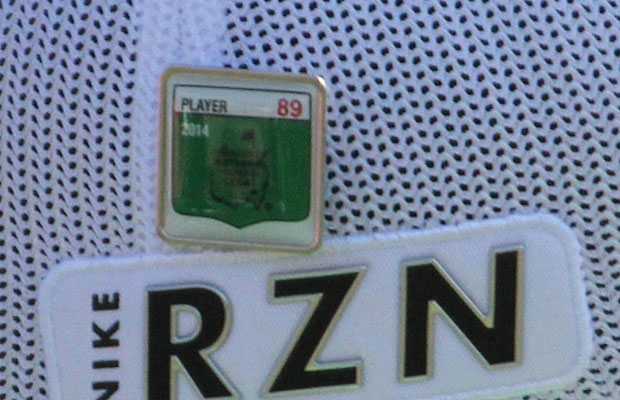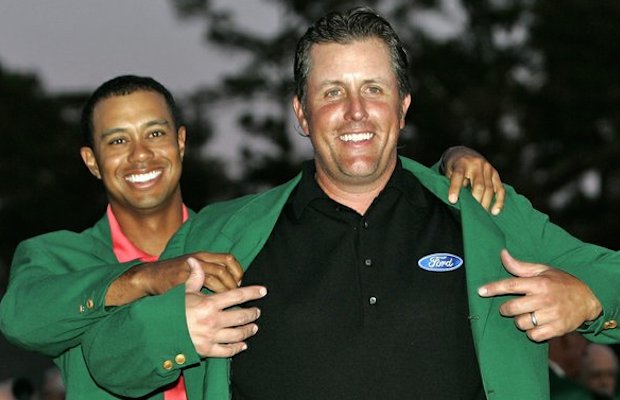Opinion & Analysis
The Masters gets it right

No matter what happens on the back nine of Sunday at the Masters, viewers are left with a lasting image and a memory that is unique from golf’s three other major championships. While Sunday’s rendition of Augusta’s back nine might have fell short of expectations in the drama department, with Bubba Watson holding onto a three-shot lead from the 12th hole until the finish line, what happened during yesterday afternoon at the Masters will most definitely leave a lasting impression on golf in the years to come.
Golf fans witnessed 20-year old Jordan Spieth prove to the world that his name will be seen on major championship leaderboards soon again and quite often. His tenacity and knack for competition at an early age is something for which golf fans have yearned, and his appetite for winning only could have grown stronger after yesterday’s defeat. We also watched Bubba Watson cure his 2012 Green Jacket hangover by showing yet again that “Bubba-Golf” might just be the Masters fields’ biggest enemy.
Yes, the unique feeling that golf fans share with regards to the Masters has plenty to do with how it is the only major played on the same course every year, but there’s more to it than that. The images and the memories that we are left with, in my opinion, are not necessarily a result of the iconic golf shots that have resulted in Green Jacket glory over the years, but from the countless “perfect” details about the course and the tournament in general that create the stage for such shots to stand out in our minds. To sum it up, come Sunday evening in mid–April, the Masters always wins.
After receiving an envelope in the mail from the Masters Tournament in the late fall with a pair tickets to Wednesday’s practice rounds, I would get the opportunity to uncover all of the mystique, the expectation and the “perfection” I had been hearing, dreaming and probably talking about way too much for the last decade.
One of the things a patron will notice about Augusta National for the first time is the immense size of the property. From the recently constructed practice facility (which I will discuss below), to the par-3 course and the concession and merchandise areas, the landscape of the Augusta National property is gigantic. While the property is so grand, spectators will also notice that the actual golf course — from the 1st tee to the 18th green — is actually very close together, and here’s why.
When Bobby Jones and Clifford Roberts embarked upon this landscape in Augusta, Ga., in 1930, their intention was not to just build a golf course, which one could argue was the intention of maybe every other course ever constructed in the world. They settled on this property with the goal of creating a tournament and spectacle. It’s almost as if Jones and Roberts had the ability to look into the future to 2005; when Tiger holed out from the left fringe on No. 16, or in 2010 when Phil struck his 6 iron out of the pine-straw to establish the courses most influential holes coming down the stretch in area of the property where the noise and reaction of the crowd would radiate in a amphitheater, manufacturing a noise and a creating a buzz that could not be matched in this sport.
While standing at the practice green situated right in front of the clubhouse, which looks out over the entire golf course, I could hear patron’s chant “skip it, skip it” as players participated in the 16th hole practice round tradition of skipping it over the water onto the green. I could only imagine the sounds a Sunday roar could create, as the ones I witnessed on a Wednesday managed to send chills down my spine.
Another aspect of perfection and genius that caught my eye, which I don’t think many others would have picked up on, was on the practice facility, and I emphasize the word practice. First, I think I can answer this question for all of you… have you ever been on a driving range where there isn’t a green as a target at the very end for your longest club? I am 99.9 percent sure that the answer is no, but if you have then please say so!
At the Augusta National range, the farthest green from the tees is about 230 yards away. Beyond this green are clump of trees separating the range into a Y shape, creating two separate fairways. While watching players hitting drivers and 3 woods to both to the right and left sides of the range, a light bulb went off in my head and I yelled out loud to my dad, “It makes perfect sense!” How often in a round do you hit a tee ball that isn’t on a par-3 to a green? The answer is never, unless it’s a drivable par-4.
The end of the range is set up so that you practice hitting tee balls to locations similar to the course. There is also a set of fairway bunkers along the right side of the range at the 300-yard distance, so players can practice hitting a tee ball in between a set of trees and a set of bunkers, just like on the course. It actually makes so much sense and it’s really quite simple when you think about, but still, Augusta National is the only place that I’ve seen it done.
While I believe Augusta National’s decision to allow female members to the club was one that could have come a decade or so earlier, I will finish off by alluding to what might turn out to be the most impactful decisions the Masters committee has made in recent years with regards to the growth of the game. Last year, Masters Chairman Billy Payne announced the finals for the Drive, Chip, and Putt competition – a golf skills contest in America for girls and boys ages 7-to-15 – would be hosted at Augusta National.
While much wasn’t made of such a decision at first, the televised coverage of the event created a stir among golf’s leading influencers that was centered around the overwhelming positive impression the initiative will have on the game. For those kids who didn’t qualify or didn’t even attempt to be the first Drive, Chip and Putt contestants to hit golf shots on the course, I’m sure that after seeing Bubba Watson and Jordan Spieth fist pumping and high fiving all the participants has driven hundreds of thousands of young kids to want to work harder, or even pick up the game in order to have that opportunity next year and in the years to come. The impact that a little detail like having the 2013 Masters Champion, Adam Scott, hand out the trophies to the competitions winners may have made this initiative and this new Masters traditions one of the best one’s since the clubs inception.
In recent years, the Masters Committee has also established its roots internationally, inviting the winners of amateur events in Asia and South America to play in the Masters. The growth of the game, or lack there of, is a much-debated topic in golf. While I don’t believe it is the responsibility of the Masters Tournament and the Augusta National Golf Club to fix whatever issues the game might face, the fine men in their Green Jackets do in fact realize and utilize the influence their club and their tournament has on the game.
The decisions they make — from where they place the greens on the practice facility, the $1.50 sandwiches and growing the game in fast-growing continents around the world — are always the right ones and seem to have impacted the game of golf in the highest regard.
Opinion & Analysis
The 2 primary challenges golf equipment companies face

As the editor-in-chief of this website and an observer of the GolfWRX forums and other online golf equipment discourse for over a decade, I’m pretty well attuned to the grunts and grumbles of a significant portion of the golf equipment purchasing spectrum. And before you accuse me of lording above all in some digital ivory tower, I’d like to offer that I worked at golf courses (public and private) for years prior to picking up my pen, so I’m well-versed in the non-degenerate golf equipment consumers out there. I touched (green)grass (retail)!
Complaints about the ills of and related to the OEMs usually follow some version of: Product cycles are too short for real innovation, tour equipment isn’t the same as retail (which is largely not true, by the way), too much is invested in marketing and not enough in R&D, top staffer X hasn’t even put the new driver in play, so it’s obviously not superior to the previous generation, prices are too high, and on and on.
Without digging into the merits of any of these claims, which I believe are mostly red herrings, I’d like to bring into view of our rangefinder what I believe to be the two primary difficulties golf equipment companies face.
One: As Terry Koehler, back when he was the CEO of Ben Hogan, told me at the time of the Ft Worth irons launch, if you can’t regularly hit the golf ball in a coin-sized area in the middle of the face, there’s not a ton that iron technology can do for you. Now, this is less true now with respect to irons than when he said it, and is less and less true by degrees as the clubs get larger (utilities, fairways, hybrids, drivers), but there remains a great deal of golf equipment truth in that statement. Think about it — which is to say, in TL;DR fashion, get lessons from a qualified instructor who will teach you about the fundamentals of repeatable impact and how the golf swing works, not just offer band-aid fixes. If you can’t repeatably deliver the golf club to the golf ball in something resembling the manner it was designed for, how can you expect to be getting the most out of the club — put another way, the maximum value from your investment?
Similarly, game improvement equipment can only improve your game if you game it. In other words, get fit for the clubs you ought to be playing rather than filling the bag with the ones you wish you could hit or used to be able to hit. Of course, don’t do this if you don’t care about performance and just want to hit a forged blade while playing off an 18 handicap. That’s absolutely fine. There were plenty of members in clubs back in the day playing Hogan Apex or Mizuno MP-32 irons who had no business doing so from a ballstriking standpoint, but they enjoyed their look, feel, and complementary qualities to their Gatsby hats and cashmere sweaters. Do what brings you a measure of joy in this maddening game.
Now, the second issue. This is not a plea for non-conforming equipment; rather, it is a statement of fact. USGA/R&A limits on every facet of golf equipment are detrimental to golf equipment manufacturers. Sure, you know this, but do you think about it as it applies to almost every element of equipment? A 500cc driver would be inherently more forgiving than a 460cc, as one with a COR measurement in excess of 0.83. 50-inch shafts. Box grooves. And on and on.
Would fewer regulations be objectively bad for the game? Would this erode its soul? Fortunately, that’s beside the point of this exercise, which is merely to point out the facts. The fact, in this case, is that equipment restrictions and regulations are the slaughterbench of an abundance of innovation in the golf equipment space. Is this for the best? Well, now I’ve asked the question twice and might as well give a partial response, I guess my answer to that would be, “It depends on what type of golf you’re playing and who you’re playing it with.”
For my part, I don’t mind embarrassing myself with vintage blades and persimmons chasing after the quasi-spiritual elevation of a well-struck shot, but that’s just me. Plenty of folks don’t give a damn if their grooves are conforming. Plenty of folks think the folks in Liberty Corner ought to add a prison to the museum for such offences. And those are just a few of the considerations for the amateur game — which doesn’t get inside the gallery ropes of the pro game…
Different strokes in the game of golf, in my humble opinion.
Anyway, I believe equipment company engineers are genuinely trying to build better equipment year over year. The marketing departments are trying to find ways to make this equipment appeal to the broadest segment of the golf market possible. All of this against (1) the backdrop of — at least for now — firm product cycles. And golfers who, with their ~15 average handicap (men), for the most part, are not striping the golf ball like Tiger in his prime and seem to have less and less time year over year to practice and improve. (2) Regulations that massively restrict what they’re able to do…
That’s the landscape as I see it and the real headwinds for golf equipment companies. No doubt, there’s more I haven’t considered, but I think the previous is a better — and better faith — point of departure when formulating any serious commentary on the golf equipment world than some of the more cynical and conspiratorial takes I hear.
Agree? Disagree? Think I’m worthy of an Adam Hadwin-esque security guard tackle? Let me know in the comments.
@golfoncbs The infamous Adam Hadwin tackle ? #golf #fyp #canada #pgatour #adamhadwin ? Ghibli-style nostalgic waltz – MaSssuguMusic
Podcasts
Fore Love of Golf: Introducing a new club concept

Episode #16 brings us Cliff McKinney. Cliff is the founder of Old Charlie Golf Club, a new club, and concept, to be built in the Florida panhandle. The model is quite interesting and aims to make great, private golf more affordable. We hope you enjoy the show!
Opinion & Analysis
On Scottie Scheffler wondering ‘What’s the point of winning?’

Last week, I came across a reel from BBC Sport on Instagram featuring Scottie Scheffler speaking to the media ahead of The Open at Royal Portrush. In it, he shared that he often wonders what the point is of wanting to win tournaments so badly — especially when he knows, deep down, that it doesn’t lead to a truly fulfilling life.
View this post on Instagram
“Is it great to be able to win tournaments and to accomplish the things I have in the game of golf? Yeah, it brings tears to my eyes just to think about it because I’ve literally worked my entire life to be good at this sport,” Scheffler said. “To have that kind of sense of accomplishment, I think, is a pretty cool feeling. To get to live out your dreams is very special, but at the end of the day, I’m not out here to inspire the next generation of golfers. I’m not out here to inspire someone to be the best player in the world, because what’s the point?”
Ironically — or perhaps perfectly — he went on to win the claret jug.
That question — what’s the point of winning? — cuts straight to the heart of the human journey.
As someone who’s spent over two decades in the trenches of professional golf, and in deep study of the mental, emotional, and spiritual dimensions of the game, I see Scottie’s inner conflict as a sign of soul evolution in motion.
I came to golf late. I wasn’t a junior standout or college All-American. At 27, I left a steady corporate job to see if I could be on the PGA Tour starting as a 14-handicap, average-length hitter. Over the years, my journey has been defined less by trophies and more by the relentless effort to navigate the deeply inequitable and gated system of professional golf — an effort that ultimately turned inward and helped me evolve as both a golfer and a person.
One perspective that helped me make sense of this inner dissonance around competition and our culture’s tendency to overvalue winning is the idea of soul evolution.
The University of Virginia’s Division of Perceptual Studies has done extensive research on reincarnation, and Netflix’s Surviving Death (Episode 6) explores the topic, too. Whether you take it literally or metaphorically, the idea that we’re on a long arc of growth — from beginner to sage elder — offers a profound perspective.
If you accept the premise literally, then terms like “young soul” and “old soul” start to hold meaning. However, even if we set the word “soul” aside, it’s easy to see that different levels of life experience produce different worldviews.
Newer souls — or people in earlier stages of their development — may be curious and kind but still lack discernment or depth. There is a naivety, and they don’t yet question as deeply, tending to see things in black and white, partly because certainty feels safer than confronting the unknown.
As we gain more experience, we begin to experiment. We test limits. We chase extreme external goals — sometimes at the expense of health, relationships, or inner peace — still operating from hunger, ambition, and the fragility of the ego.
It’s a necessary stage, but often a turbulent and unfulfilling one.
David Duval fell off the map after reaching World No. 1. Bubba Watson had his own “Is this it?” moment with his caddie, Ted Scott, after winning the Masters.
In Aaron Rodgers: Enigma, reflecting on his 2011 Super Bowl win, Rodgers said:
“Now I’ve accomplished the only thing that I really, really wanted to do in my life. Now what? I was like, ‘Did I aim at the wrong thing? Did I spend too much time thinking about stuff that ultimately doesn’t give you true happiness?’”
Jim Carrey once said, “I think everybody should get rich and famous and do everything they ever dreamed of so they can see that it’s not the answer.”
Eventually, though, something shifts.
We begin to see in shades of gray. Winning, dominating, accumulating—these pursuits lose their shine. The rewards feel more fleeting. Living in a constant state of fight-or-flight makes us feel alive, yes, but not happy and joyful.
Compassion begins to replace ambition. Love, presence, and gratitude become more fulfilling than status, profits, or trophies. We crave balance over burnout. Collaboration over competition. Meaning over metrics.
Interestingly, if we zoom out, we can apply this same model to nations and cultures. Countries, like people, have a collective “soul stage” made up of the individuals within them.
Take the United States, for example. I’d place it as a mid-level soul: highly competitive and deeply driven, but still learning emotional maturity. Still uncomfortable with nuance. Still believing that more is always better. Despite its global wins, the U.S. currently ranks just 23rd in happiness (as of 2025). You might liken it to a gifted teenager—bold, eager, and ambitious, but angsty and still figuring out how to live well and in balance. As much as a parent wants to protect their child, sometimes the child has to make their own mistakes to truly grow.
So when Scottie Scheffler wonders what the point of winning is, I don’t see someone losing strength.
I see someone evolving.
He’s beginning to look beyond the leaderboard. Beyond metrics of success that carry a lower vibration. And yet, in a poetic twist, Scheffler did go on to win The Open. But that only reinforces the point: even at the pinnacle, the question remains. And if more of us in the golf and sports world — and in U.S. culture at large — started asking similar questions, we might discover that the more meaningful trophy isn’t about accumulating or beating others at all costs.
It’s about awakening and evolving to something more than winning could ever promise.

















BallBuster
Apr 16, 2014 at 1:04 pm
I don’t think the Masters got it right in recent years and what seems to be their future course. I’m losing interest in the Sunday round at Augusta. There won’t be anymore back 9 charges like Jack had in 86. I doubt there will be many late birdie rallies like O’Meara had several years ago to steal a win.
Bubba did what one has to do anymore. Just hang on. It will be in the leader’s hands. Rory was an example of going cold and losing the lead. Someone may shoot a 69 to make a “move”, but unless the leader throws away shots, it’s a slow march that other will have a very hard time overcoming. I liked the old days better. Making moves up the leaderboard and the roars of the crowd.
The average winner’s score form the last 15 years since the Tiger-proofing began is just over 69 in the final round. Couple that with the fact the winner has come from that last group over 80% of the time means that as long as you shoot OK, no one can charge past you unlike many times in the past. The worst is Trevor Immelman shooting a 75 and no one could still come within 3 strokes. Boring.
Philip
Apr 16, 2014 at 3:00 pm
what about bubba birdieing 13-16 in the final round in 2012 to force a playoff and schwartzel birdieing the final 4 holes in 2011 to win outright? that not enough of a “charge”?
Ed
Apr 16, 2014 at 12:08 pm
I dunno. I still don’t like the way they did the coverage on ESPN. It was awful.
Ryan
Apr 15, 2014 at 2:17 pm
great article